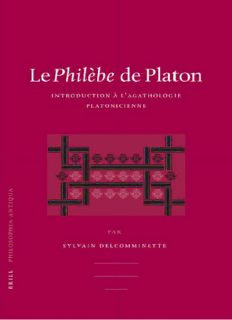Table Of ContentLE PHILÈBE DE PLATON
PHILOSOPHIA ANTIQUA
A SERIES OF STUDIES
ON ANCIENT PHILOSOPHY
PREVIOUS EDITORS
† †
J.H. WASZINK , W.J. VERDENIUS , J.C.M. VAN WINDEN
EDITED BY
K.A. ALGRA, F.A.J. DE HAAS
J. MANSFELD, D.T. RUNIA
VOLUME C
S. DELCOMMINETTE
LE PHILÈBEDE PLATON
LE PHILÈBE DE PLATON
introduction à l agathologie platonicienne
’
PAR
S. DELCOMMINETTE
BRILL
LEIDEN •BOSTON
2006
Publié avec le concours de la Fondation Universitaire de Belgique
This book is printed on acid-free paper.
Library of Congress Cataloging-in-Publication Data
Delcomminette, Sylvain.
Le Philèbede Platon : introduction à l’agathologie platonicienne / par
S. Delcomminette.
p. cm. — (Philosophia antiqua, ISSN 0079-1687 ; v. 100)
Includes bibliographical references and index.
ISBN90-04-15026-9 (hard : alk. paper)
1. Plato. 2. Pleasure. 3. Plate. Philebus. I. Title. II. Series.
B398.P56D45 2006
1 1’.4—dc27
2006042538
ISSN 0079-1687
ISBN 90 04 15026 9
© Copyright 2006 by Koninklijke Brill NV, Leiden, The Netherlands
Koninklijke Brill NV incorporates the imprints Brill Academic Publishers,
Martinus Nijhoff Publishers and VSP.
All rights reserved. No part of this publication may be reproduced, translated, stored in
a retrieval system, or transmitted in any form or by any means, electronic,
mechanical, photocopying, recording or otherwise, without prior written
permission from the publisher.
Authorization to photocopy items for internal or personal
use is granted by Brill provided that
the appropriate fees are paid directly to The Copyright
Clearance Center, 222 Rosewood Drive, Suite 910
Danvers MA 01923, USA.
Fees are subject to change.
printed in the netherlands
«Être conséquent est l’obligation principale
d’un philosophe, et c’est ce que l’on ren-
contrelemoinssouvent.»
—Kant
Socrate:«Envérité,trèscher,moidumoins,
jepensequ’ilvautmieuxquelalyresoitdis-
cordanteetdissonante,oumêmeunchœur
que je devrais diriger, ou que la plupart des
hommesne soientpasd’accord avecmoiet
mecontredisent,plutôtque,moiquisuisun,
de ne pas être d’accord avec moi-même et
demecontredire.»
—Platon
TABLE DES MATIÈRES
Remerciements..................................................... xiii
Avertissement....................................................... xv
Introduction........................................................ 1
Première Partie
ÉLABORATION DU PROBLÈME
ChapitreI:Miseenplace ......................................... 23
§1. Lespositionspréliminaires............................... 23
§2. Laprédicationdubien.................................... 28
§3. Préparatifspourladiscussion............................ 33
§4. Lestroisproblèmes........................................ 39
ChapitreII:L’unetlemultiple .................................. 51
§1. Lesproblèmesdel’unetdumultiple................... 51
a. Lesproblèmespuérils................................. 51
b. Lesproblèmessérieux ................................ 55
1. Letexte ............................................. 55
2. Lesproblèmes...................................... 59
3. Oùsetrouvelasolutiondecesproblèmes?.... 74
c. Organisationdialectiquedesproblèmesdel’un
etdumultiple .......................................... 77
§2. Sophistiqueetdialectique ................................ 78
a. L’originelinguistiquedel’identificationentre
l’unetlemultiple...................................... 78
b. Lasophistique.......................................... 83
c. Ladialectique .......................................... 91
1. Descriptionexterne ............................... 91
viii tabledesmatières
2. Descriptioninterne................................ 96
a. Lepointdedépart ............................ 96
b. Lerassemblement.............................101
c. Ladivision......................................110
d. L’abandondesespècesdansl’apeiron.......125
3. Lesexemples.......................................130
ChapitreIII:Premièreapprochedubien ......................161
§1. LesplaintesdeProtarque.................................161
§2. Unenouvellevoiepourunnouveauproblème........164
§3. Lescritèresdubien........................................165
§4. Laméthode.................................................169
§5. Laviedeplaisir ............................................172
§6. Lavied’intelligence.......................................183
§7. Laviemixte.................................................186
§8. Lacause.....................................................194
§9. Lesgainsdialectiquesdecettesectiondudialogue...198
ChapitreIV:Mélanges ............................................201
§1. Delaméthodedivineàladivisionquadripartite ......201
§2. Ladivisionquadripartite..................................212
a. Lecadredeladivision ................................212
b. τ(cid:3)(cid:4)πειρ(cid:9)ν...............................................216
c. τ(cid:3)π(cid:11)ρας .................................................230
d. τ(cid:3)μεικτ(cid:15)ν................................................242
e. (cid:16)α(cid:17)τ(cid:18)α....................................................248
§3. Applicationdeladivisionquadripartiteauproblème
delaviemixte..............................................258
§4. Deladivisionquadripartiteàlaméthodedivine ......276
tabledesmatières ix
Deuxième Partie
LES DIVISIONS
première section: les plaisirs
ChapitreV:L’analyseduplaisirdansl’économiedu
dialogue ..........................................................289
ChapitreVI:Lecadregénéraldel’analyse.....................297
§1. Pointdevueexterne ......................................297
a. Premièreespèce .......................................297
b. Deuxièmeespèce......................................303
c. Lapossibilitéd’unétatneutre .......................310
§2. Pointdevueinterne.......................................313
a. Versunereconstructiondelagenèselogiquedes
pouvoirsdel’âme......................................313
b. Lasensation ............................................315
c. Lamémoire ............................................321
d. Laréminiscence .......................................324
e. Ledésir..................................................330
f. Laviedanslesmélanges..............................345
ChapitreVII:Lesplaisirsfaux....................................349
§1. Leproblèmedelavéritéetdelafaussetéduplaisir ..349
§2. Lesespècesdeplaisirsfaux...............................362
a. Premièreespèce .......................................362
1. Lerôledeladoxa danslaperception...........362
2. L’imagination ......................................375
3. Applicationaucasdesplaisirs ...................383
4. Lateneuragathologiquedelavérité............391
b. Deuxièmeespèce......................................399
c. Troisièmeespèce.......................................412
Description:This book deals with the nature and function of the good in Plato’s philosophy, by focusing on the dialogue explicitly devoted to it: the Philebus. It provides a comprehensive commentary of this difficult dialogue in which almost all the themes of Plato’s philosophy are discussed or alluded to.

